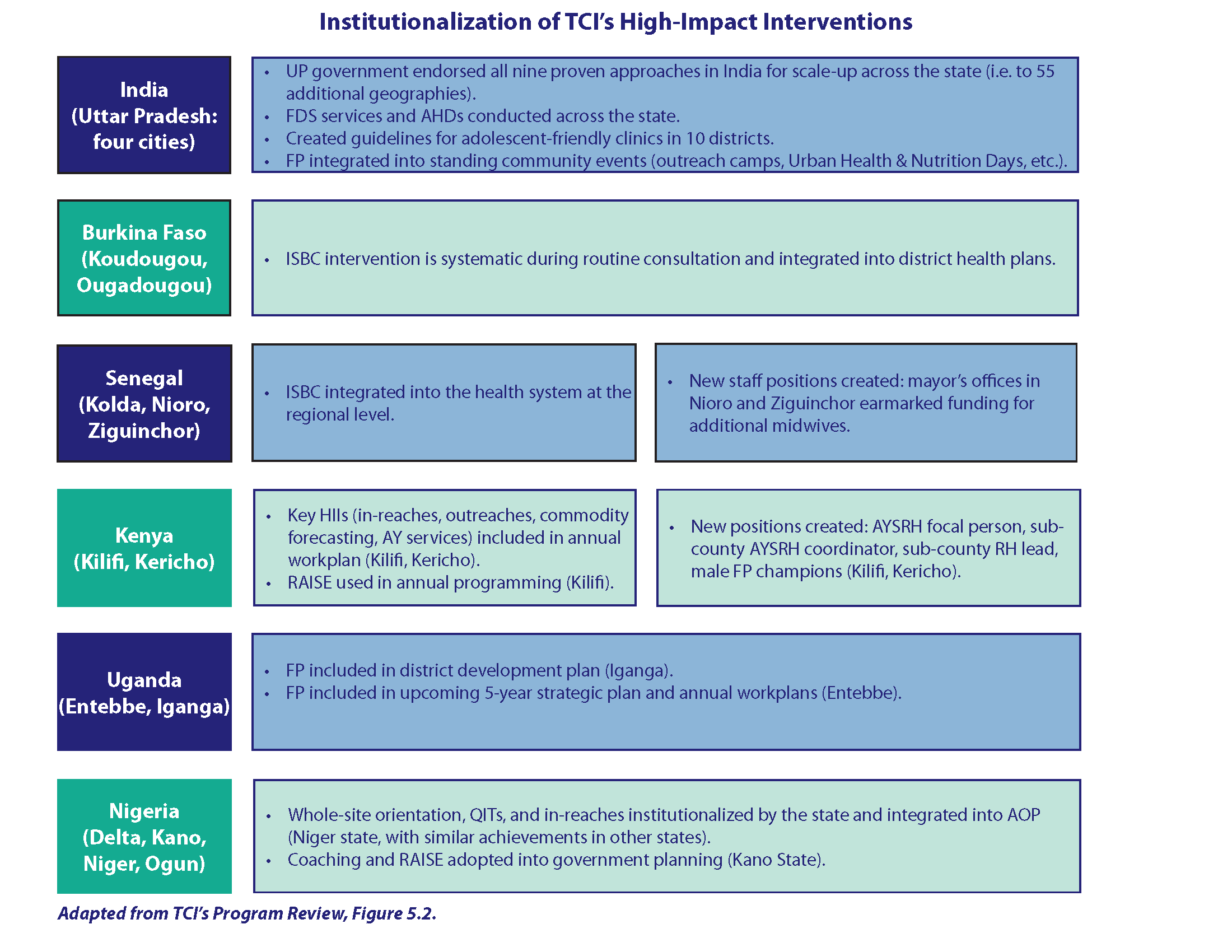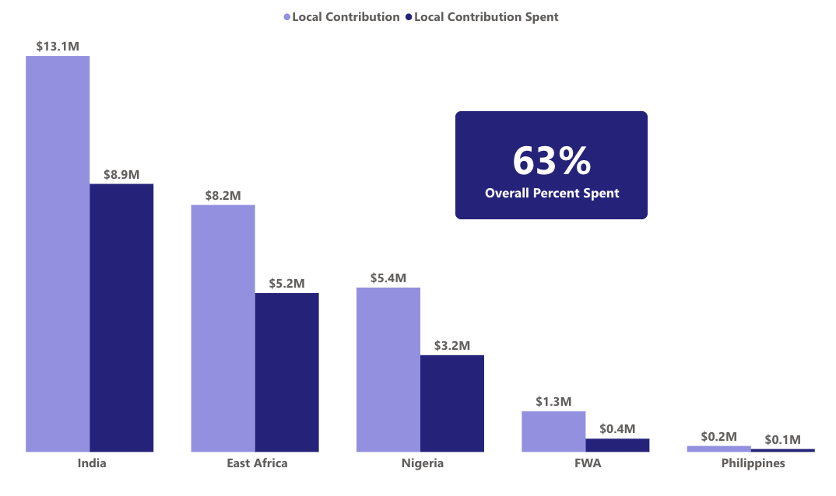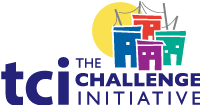- Home
- Help and Support
- Close
- Toolkits
- Global Toolkit
- AYSRH Toolkit
- Hub Toolkits
- Core High-Impact Practices
- Gender Essentials Mini Course
- Close
- Resource Collection
- Community of Practice
- Coaching
- Log In/Register
- My Profile
- English
High-Impact Practice
Increasing allocation and efficient use of domestic public financing for voluntary family planning at national and sub-national levels.
What Is It?
In order for voluntary family planning programs to be successful and sustainable, there needs to be strong national and sub-national capacity to implement and manage programs, including capacity to mobilize and spend the necessary financial resources for family planning commodities, service delivery, demand creation and training.
This is why being demand-driven is one of TCI’s guiding principles. Cities with political and financial commitment self-select to join TCI and are in the driver’s seat to design their own family planning and AYSRH programs. At a practical level, since local decision-makers determine priorities, secure resources and solidify stakeholder support, they can expedite actions and circumvent the substantial time and effort usually needed to adopt and finance innovations at scale.
A mix of financing from a variety of sources is required to achieve predictable, adequate and sustainable financing for family planning. Across TCI cities, the three primary sources of funding tend to be out of pocket expenses, national and local government revenue (or public funding) and donor funding. This high impact practice highlights how TCI supports cities to mobilize public funding for family planning programming.
What Are the Benefits?
- Ensures sufficient resources in sub-national budgets for core components of the family planning program
- Increases local buy-in, ownership and financial sustainability of high impact practices in family planning
- Enhances accountability for family planning monies by ensuring that resources committed for family planning (for example, those committed as part of Costed Implementation Plans) are used appropriately
- Enhances public resource efficiency by ensuring better coordination of all sources of funding to enable greater impact
How to Implement?
Set a realistic number of goals with cost estimates
Even before a city partners with TCI, it first must submit an expression of interest (EOI), which is scored against predefined selection criteria to choose among candidate cities and ensure eligibility for gap funding from TCI through The Challenge Fund. The predefined selection criteria include political commitment, resource contribution, system readiness, size for potential impact and composition of the local government program design and implementation team.
Once a city’s EOI is approved by TCI, it then proceeds to the program design phase which includes coaching from TCI on landscaping and gap analysis and ultimately the selection of high impact practices and other TCI interventions to meet those gaps. Once the priority interventions are identified, it is important to match them with corresponding budget or allocation to ensure that they can be feasibly implemented and sustained. The budgeting of activities should take into consideration the specific component activities and items that are to be considered in the implementation of the intervention. This results in a costed program design that is reviewed and adjusted annually based on progress made and mobilized resources available.
This process is most successful when it includes a wide range of stakeholders from different municipal departments, implementing partners and private sector. It promotes transparency, coordination and partnership, which enables funding to be leveraged from different sources so that it can be used more efficiently and effectively to better serve the community and ensures that local government can more effectively lead and manage its overall family planning program.
In the Philippines, for example, local government units (LGUs) can tap into the following sources of funding for its family planning and adolescent and youth sexual and reproductive health (AYSRH) programming.
- Statutory Allocations:
- Sangguniang Kabataan Funds (10%) – Sec. 20 (a), RA 10742: 10% of the general fund of the barangay shall be set aside for the Sangguniang Kabataan. The Sangguniang Barangay shall appropriate the Sangguniang Kabataan funds in lump-sum, which shall be disbursed solely for youth development and empowerment purposes.
- Magna Carta of Women (RA 9710): Use of Gender and Development (GAD) budget for AYSRH (5% of LGU fund).
- Children Fund (1%) – Republic Act 9344 or the Juvenile Justice and Welfare Act of 2006: 1% of the Internal Revenue Allotment (IRA) are allotted for programs and projects of the local councils for the protection of children (LCPC).
- Other local funds: Funds from other local offices, such as the health, population, social welfare and other related structures, that may provide financial assistance through integration of identified AYSRH interventions in their respective work and financial plans or through joint implementation initiatives with financial counter-parting.
- Private/NGO sector partnerships/development partners: May involve private institutions or international and local development partners that provide grants or financial assistance for AYSRH-related interventions. Requests for funding are usually aligned within their institutional priorities.
Develop a clear understanding of the annual budget cycle
All hubs provide coaching support to local government stakeholders related to each stage of the budget process, preparing the annual budget and monitoring releases.
Stakeholders should come together on monthly and/or quarterly basis to monitor progress of both activities and releases.
Examples:
In East Africa, the program implementation team (PIT) comprised of local government stakeholders, private sector representatives and implementing partners conduct monthly review meetings to assess the implementation of program activities and financial progress. Share the review meeting findings with the Reproductive Health Coordinator and plan for next month’s activities. Participate in feedback meetings with local governments’ budget committees to share progress and impact from funds allocated.
In Nigeria, Advocacy Core Group (ACG) members compile a report that compares family planning expenditures against the approved budget. These reports are then used to debrief policymakers about how the budgets are really being used. This approach has contributed to the achievement of high-level support from policymakers to improve expenditures on family planning programs.
Strengthen financial management capacity and mobilize resources
Each hub employs different strategies specific to its contexts to mobilize financial resources while simultaneously strengthening budgeting and financial management capacity.
- In East Africa, TCI engages local governments directly in a contractual relationship referred to as a fixed amount sub-award to disburse the Challenge Fund to them.
- In Francophone West Africa, TCI helps local governments to establish commercial bank accounts where both TCI’s Challenge Fund and local contribution amounts are housed and monitored.
- In Nigeria, TCI does not give Challenge Fund money directly to the states, but works with them to establish a statewide family planning workplan and leverage funding from a variety of sources.
- In India, city governments are not authorized to request monetary support from external agencies (such as The Challenge Fund). However, they can seek technical assistance and program implementation support through NGOs. As a result, TCI has strengthened local government stakeholders’ capacity to adequately budget for the funding that they need to implement the high impact practices and TCI interventions to meet the needs of their most vulnerable and under-served populations in urban areas.
Invest in advocacy to galvanize commitment to family planning
TCI employs a number of strategies to build and strengthen financial management capacity to ensure release and effective spending and monitoring of committed funds. One of the first strategies employed across all hubs is advocacy efforts to ensure that local governments have a family planning budget line item instead of it being part of a composite reproductive health and maternal child health line item.
Example
For the very first time in the history of Anambra, Abia, Taraba and Delta States, dedicated budget line was created for family planning. Prior to the commencement of TCI support in the States, the State Ministry of Health has always had a composite budget line for Reproductive Health. In 2018, Anambra state allocated N30M ($83,000) in the budget for all the six priority areas of reproductive health. But, once the Initiative began activities, the need for a dedicated budget line was brought to the fore and reiterated at every opportunity. All of these efforts yielded great results. The Commissioner for Health of Anambra State directed the Department of Planning, Research and Statistics to create a separate budget line with about $140,000 (N50million) allocated to family planning, Taraba State budgeted N50 million and Delta N8Million.
For more about the Anambra story, see Dedicated Budget Line for Family Planning Created in Anambra.
Include high impact practices in family planning and TCI interventions in key strategic documents
One key factor for sustainability is whether or not local governments have institutionalized TCI’s high-impact interventions by integrating them into policies as well as local government work plans and budgets. TCI has succeeded in ensuring the sustainability of its interventions in several countries as seen in the chart below.

Track budgets to assess whether the budget for family planning is being implemented per the approved budget and timelines
Across all TCI geographies, hub work with the local government to assess the progress of program activities and the financial progress during monthly review meetings, verifying expenditures with implementers.
Example
In India, this includes the following steps:
- Disseminate information on the approved PIP and funds allocated to the district. Chief Medical Officer (CMO/CMHO/CDMO) should convene a District level meeting of all concerned units and share the line item allocations and guidelines for making decisions on future planning and utilization of funds.
- Ensure availability of approved funds for family planning activities prior to their planned implementation. This should be done by the Chief Medical Officer (CMO/CMHO/CDMO) in
coordination with the Nodal Officer for Urban Health, Family Planning, District Program Manager and District Accounts Manager. - Monthly and quarterly review of physical and financial progress of all approved FP activities.
What Is the Evidence?
-
TCI commitments in the first phase were $28.2 million but varied by hub, with India leading the way with $13.1 million, followed by East Africa at $8.2 million. In the period from July 2020 to February 2022, 73% of the local government committed funds were spent across the four hubs, with Nigeria (88%) and East Africa (87%) leading the way. Average spending by local governments across the entirety of phase one stands at 63%; as highlighted in the graph below. Local commitments made during the final five months of the first phase (Nov. 1, 2021 – Feb. 28, 2022) are not included in these calculations because they go towards activities that will occur under the second phase period.




